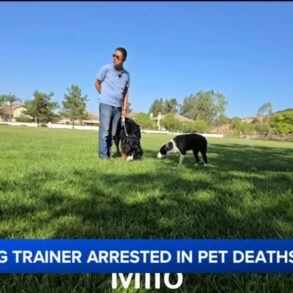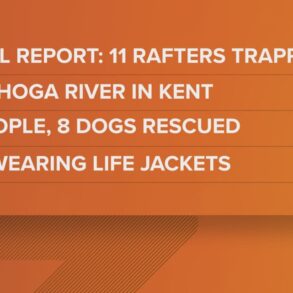Dog owners are constantly communicating with their pets. We spend a lot of time sharing affection, giving commands, scolding, or petting their adorable faces.
But how much are we really able to understand each other?
Dr. Emily Bray is a canine cognition specialist and an assistant professor of human-animal interaction at the University of Arizona. Her work explores human and canine verbal and non-verbal communication.
Bray says we often pigeonhole communication to just verbal spoken language, “but actually communication is so much more than that, whether it be their body language or their vocalizations,” she says.
Speaking, listening, reading and writing are all considered to be verbal communication skills. If we try to communicate through eye contact, pointing, or facial expressions, we’re taking advantage of nonverbal communication.
It’s obvious when dogs bark, howl, whine, or groan that they are verbally expressing distinct feelings to us. And us to them: When we ask a well-trained dog to sit, stay or heel, they happily obey the command.
But dogs are also communicating non-verbally with us all the time. It’s just that we don’t always pick up on the exact meanings behind all of their actions, or even notice some of these cues.




Chris KITTREDGE
Like when a dog wags its tail we tend to think it’s happy. But a study of varying breeds at the University of Trieste suggests there might be more to it.
Did you know that dog tail wags aren’t symmetrical? Researchers found that if a dog wags its tail more toward the right, it means something positive is happening (like they’re playing with their owner).
A follow-up study at the Chinese Academy of Sciences showed that an asymmetrical left tail wag indicates a negative experience. And if that’s coupled with lip-licking or eye contact avoidance, the dog may be experiencing discomfort.
And the position of the tail matters too. According to the American Kennel Club, the general rule is the higher the tail, the more assertive the dog. So if a dog’s tail is tucked between their legs, they’re feeling shy and probably want some space.
If the tail is pointed straight in the air, they’re feeling confident, and possibly a little aggressive.
Over the last 15 years, scientists have really started to examine how well working dogs can interpret human’s verbal and non verbal cues. Like the border collies that race through agility courses, the Anatolian shepherd dog that protects livestock overnight, and the Labrador retrievers that go duck hunting in the freezing rain.




Kerinne Levy
And then there are stars like Chaser, the famous border collie who could identify over 1,000 objects.
Bray has been working closely with guide dogs and service dogs to figure out how early a puppy’s bond with humans begins, and if the human-canine communication line could be improved.
She set up a “Puppy Pointing Study” to quantify how much service dogs (and their puppies) understand when we’re trying to communicate to them — and whether it had anything to do with genetics.
After all, humans began domesticating puppies 36,000 years ago, and after thousands of years of coexisting, these animals morphed into being our happy little sidekicks.
What Bray discovered is that puppies are now genetically predisposed to follow social cues from humans.
Because she works closely with organizations like Canine Companions — a nonprofit group that breeds docile service dogs, trains them, and then donates them to people in need — she had access to all the genetic information about all the puppies in their program.
“What’s really cool about that is that we can look at heritability of a trait. Or in other words, how much of the variation that we see is attributable to genetics as compared to the environment,” says Bray.
She discovered certain cognitive traits, like following a point or gazing at a human when they’re speaking in a high-pitched voice, are heritable. These behavioral traits appear to be passed from parent to offspring 40% of the time.




Kate The Chemist
Furthermore, the puppy’s mother and her parenting style made a difference. More successful service dogs tend to come from the “helicopter moms” of the dog world. These mother dogs usually feed their puppies while laying on their side (instead of standing) and are painted to be more stressed, since they have high cortisol rates. As a result, their puppies typically have more interest in humans, making them a good fit for connections with their handlers.
“They’re very dependent on humans, and they need to be very focused on humans,” says Bray.
On the other hand, the more paws-off moms (with lower cortisol levels) produce more independent puppies that are a better fit for guide dog training. They develop a sense of willful disobedience that is essential for making sure their owner doesn’t put themselves in dangerous situations, since they can see what’s happening while their handler cannot
“Often they have to make decisions that’s not being directly influenced by the handler,” she says.
Researchers from universities in Arizona, North Carolina, Hungary, and Germany have all tried to replicate these studies with wolves and chimps, but no other animal has been able to naturally communicate with humans without significant training.
Bray says playing with puppies on a regular basis is rewarding and fun work, but there is still so much to discover.
“What we find can quite literally improve the lives of dogs and people,” she says. “I think actually, they often do a better job of reading us than we do of them.”
She acknowledges that every dog — just like every human — is different. But Bray encourages dog owners to set up their dog for success by learning some basic dog communication signals:
- For example, if your dog’s ears are tucked back and the tail is between the legs, a lot of times that means they are scared and need to to be reassured from someone who has a known positive relationship.
- If a dog is licking their lips when food is not present, they might be unsure.
- If a puppy puts its butt in the air and its elbows on the ground, or lifts one paw in the air like they are ready to shake your hand from a standing position, it’s play time.
“Observe, watch, see what your dog is doing,” says Bray. “That all means something, and so just being more in tune with that and, then also how what you’re doing is impacting them.”
Want to know about canine communication? Listen to the latest episode of the KCUR Studios podcast Seeking a Scientist.
Additional sources from Seeking A Scientist:
Seeking A Scientist is a production of KCUR Studios. It’s made possible with support from the Stowers Institute for Medical Research, where scientists work to accelerate our understanding of human health and disease.
It’s hosted by Dr. Kate Biberdorf, AKA Kate the Chemist. Our senior producer is Suzanne Hogan. Our editor is Mackenzie Martin. Our digital editor is Gabe Rosenberg.
This episode was mixed by Suzanne Hogan with support from David McKeel, Anna Schmidt, Byron Love and Genevieve DesMarteau.
Our original theme music is by The Coma Calling. Additional music from Blue Dot Sessions.
This post was originally published on this site be sure to check out more of their content.













































